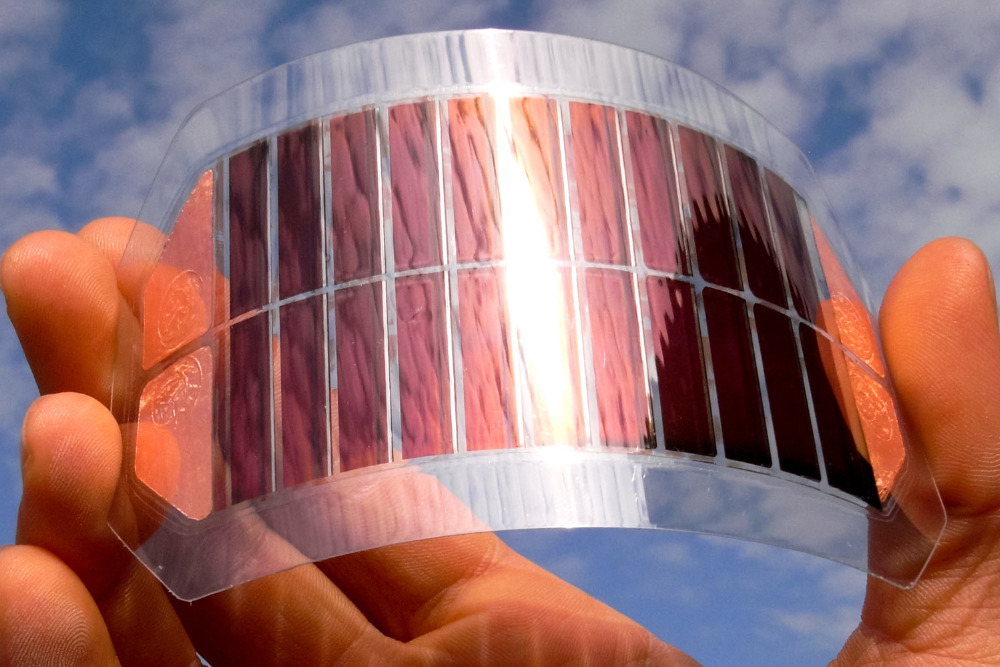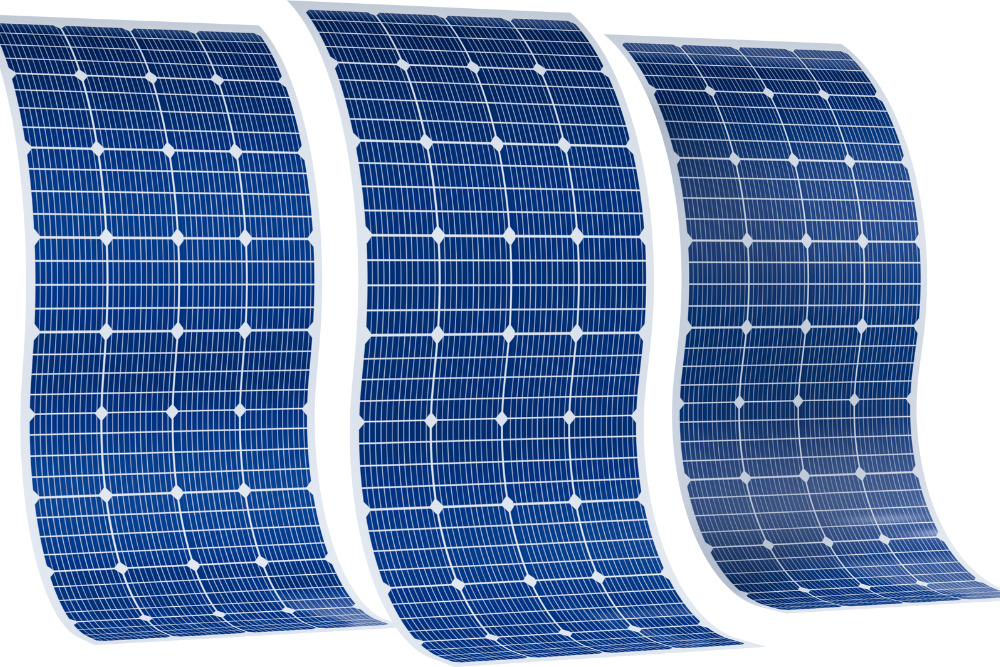
Flexible solar panels are lightweight, thin, and bendable. They’re perfect for curved surfaces, like architectural elements, or where heavy rigid panels would be too cumbersome, like on an RV.
How Do Flexible Solar Panels Work?
Flexible solar panels, also called thin-film panels, work like regular photovoltaic panels by converting sun power into solar energy. The most significant difference between flexible panels and traditional crystalline silicon panels is the type of solar cells used. Flexible panels use thin-film solar cells, which are made of various semiconductor materials. These thin films can be as thin as a few micrometers, whereas traditional panels use thicker silicon wafers.
For this reason, they're thin, lightweight, and bendable.
Like other solar panels, they require inverters and wiring to convert direct current to alternating current to make the energy available for use in homes and businesses.
Pros & Cons Of Flexible Solar Panels
Flexible solar panels come with various advantages due to their unique solar technology. However, they have their downsides as well.
Pros
- They're flexible: Flexible solar panels are made of thin solar cells on flexible materials such as plastic and fabric (for ultra-thin solar panels). Therefore, they're highly bendable and hence perfect for many unique applications. For example, if your roof is curved or you want to install solar on uneven surfaces, these panels are your best option since they can take on different shapes.
- They're lightweight: Flexible solar panels are highly portable. You can install them on weak surfaces like a cabin's metal roof or the top of an RV since they don't need heavy-duty mounting systems.
- They're cheap: Most flexible solar panels are made from low-cost materials, making them more affordable than monocrystalline and polycrystalline panels. The manufacturing process is efficient, allowing for faster and cheaper production.
- Flexible panels are easy to install: Unlike the standard solar panels, flexible panels have minimal labor costs since they're easier to handle and install. They don't need mounting systems, and you can do a DIY installation. But, you'll still need permits and documentation for DIY solar installations.

Cons
- Low energy rating: Flexible solar panels have a lower efficiency than other solar modules, ranging from around 7-15%. For comparison, most standard residential and commercial monocrystalline panels have an efficiency of about 20%.
- They require a large installation space: Due to their low power output, flexible panels take up a lot of space since you’ll need more panels to generate the same amount of energy as silicon panels.
- Short lifespan: Flexible solar panels are less durable than conventional solar panels. Some types are made from organic materials, like carbon, which wear faster. This means they have lower returns on investment since you need to replace them every few years. Some manufacturers give flexible panels a 5-10 years warranty, while standard solar panels can last up to 30 years.
What's The Highest Output Flexible Solar Panel?
Flexible solar panels have lower efficiency than their rigid silicon counterparts. Generally, their efficiency ranges between 7-15%.
However, some have combined various solar technologies to improve their energy efficiency.
One of the best flexible solar panels is the 200 Watt 12 Volt Flexible Monocrystalline Solar Panel from Renogy.
The solar panel is foldable within 240° so it's perfect for uneven surfaces. It has a higher efficiency due to its PERC solar technology and monocrystalline cells that boost energy output. Its efficiency rating is 22% and it will maintain 80% output efficiency for 25 years.
In addition, it's suitable for DIY installations since it has grommet mounting holes and solar connector cables.
What Are The Best Uses For Flexible Solar Panels?
- Uneven Surfaces: Flexible solar panels are designed to conform to irregular or curved surfaces, making them ideal for installation on uneven terrain, curved roofs, or structures with non-standard shapes. They can adapt to the contours of the surface, maximizing energy capture.
- Recreational Vehicles (RVs): Flexible solar panels are a popular choice for RV owners looking to harness solar energy for power while on the road. They can be easily affixed to the curved surfaces of RV roofs and are lightweight, making them suitable for mobile applications.
- Boats and Marine Applications: Boaters can benefit from flexible solar panels to charge batteries and power onboard appliances. These panels are especially valuable for sailboats and yachts, where weight and space are critical considerations.
- Backpacking and Camping: Portable and lightweight, flexible solar panels are a valuable source of renewable power for outdoor enthusiasts. They can be attached to backpacks, tents, or unfolded on the ground to charge devices and provide lighting.
- Remote Locations: In off-grid or remote areas where traditional power sources are unavailable, flexible solar panels can provide a reliable source of electricity. They are particularly useful for powering remote cabins, weather stations, or communication equipment.
- Emergency and Disaster Relief: During emergencies or natural disasters, flexible solar panels can be quickly deployed to provide essential power for emergency lighting, communication devices, and medical equipment in areas without access to the grid.
- Agricultural and Farming: Flexible solar panels can be used in agricultural settings to provide power for irrigation pumps, lighting in greenhouses, or to charge electric fences. Their adaptability is useful for various farm structures.
- Architectural Integration: Some architects incorporate flexible solar panels into building designs, allowing them to blend seamlessly with architectural elements such as façades, awnings, or canopies. This integration combines energy generation with aesthetics.
- Portable Charging Stations: Flexible solar panels can be used to create portable charging stations for electronic devices and small appliances at outdoor events, festivals, or public spaces.
- Educational and Research Projects: Flexible solar panels are often used in educational settings to demonstrate solar power concepts. They are also valuable in scientific research projects, particularly in remote or challenging environments.
- Off-Grid Lighting: Flexible solar panels can power outdoor lighting fixtures in gardens, pathways, and parks without the need for electrical wiring or batteries.
- DIY Projects: Hobbyists and DIY enthusiasts can use flexible solar panels to create custom solar-powered gadgets, such as solar backpacks, solar chargers, or solar-powered phone booths.


